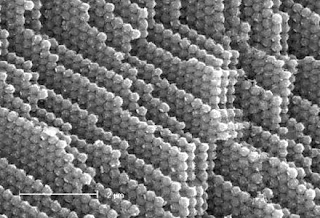Self-cleaning glass and fabrics, wallet-size cards that unfold into brochures, nylon rope and protective Kevlar® vests, toy ornithopters...what do they all have in common? They were inspired by surfaces and structures found in plants and animals. After fifty years of "modern" and "post-modern" design trends that led to boxy buildings, shiny and uncomfortable furniture, and coffee pots that won't pour without dripping, a refreshing reversal of this denial of nature is leading to amenities that have been hidden on leaves, in spider webs, and atop insect wings all along.
On a visit to southern Louisiana some years ago, our little son was quite enamored of "glass lizards", whose nickname had a double meaning. They are semi-transparent geckos, so when one is on the window, you can see through it, and...it is walking right up the glass! If you're lucky, you'll see one continue right across the ceiling. The mystery of the setae on a gecko's toes was solved and published in 2002 (see this article). This natural wonder of nanostructured material is the fitting emblem of Peter Forbes's book The Gecko's Foot: Bio-Inspiration—Engineering New Materials From Nature. Bio-inspiration is the term Peter Forbes prefers, to describe the wide range of principles and products derived from the study of natural phenomena, particularly in plants and animals.
About half the content of the book concerns nanostructures. The author is careful to point out that everything living is produced by nanostructural processes; that nature can only build in a bottom-up fashion. All the myriad tissues in a plant or animal are built, cell by cell, guided by chemical gradients under genetic control, and that the secret to many processes is the nanostructures thus produced.
For example, every living cell, whether of bacteria, fungus, plant, or animal, is studded with numerous tiny natural nanomotors. These are the "molecular pumps" that move ions and small molecules against osmosis into or out of cells. All life depends on them. They have a motor, an axle, and a "waterwheel" structure, all in a space about 8nm wide by 11nm in length; a typical cell in your body has a diameter of 10-30µm, or 10,000-30,000nm, so there is plenty of room for a few thousand of them on each cell.
Let us distinguish nanostructure from two other realms of nano-things: nanoparticles and nanobots. These both engender much fear, particularly based on sensational treatments such as Michael Chrichton's Prey and the idea that virus-sized robots will turn the whole world into "gray goo". Taking the last first: nanobots, if anyone ever produces any, are decades from production, particularly if they must be self-replicating. A much better likelihood is expressed by Eric Drexler (the inventor of the idea of "gray goo"):
"Nanotechnology-based fabrication systems can be thoroughly non-biological and safe: such systeme need have no ability to move about, use natural resources, or undergo incremental mutation. Moreover, self-replication is unnecessary; the development and use of highly productive systems of nanomachinery (nanofactories) need not involve the construction or autonomous self-replicating nano-machines." Eric Drexler and Chris Phoenix, "Report on the benefits and possible dangers of nanotechnology": The Royal Society and the Royal Academy of entineering, Nanoscience and nanotechnologies: opportunities and uncertainties, 29 July 2004. Quoted by Forbes on page 25.It is worthwhile to mention that viruses count as natural self-replicating nanobots. This wikipedia article, T4 bacteriophage, describes one of the best-studied large (90nm diameter by 200nm long) viruses.
Secondly, nanoparticles are all around us. We call them dust and smoke. Many people now buy filtering devices for their homes that filter out most particles larger than 300nm with a HEPA filter. Some purifiers can remove (many or most) particles as small as 100nm. That is still bigger than most viruses and smoke particles, though it will trap all known kinds pollen and most broken parts of dust mites. But the biggest component of nanoparticle dust on a dry, windy day is rock flour, tiny artefacts of rocks and sand being ground down by natural processes. Most clay grains are smaller than one micrometer (µm), making them nanosized.
The scary part about nanoparticles is that a few materials that seldom occur as nanoparticles take on entirely new properties when finely ground to sizes around 10-50nm. These are mostly elemental metals such as silver or chromium. In a very dry atmosphere, they can persist for some time, but they are so reactive, they are quickly oxidized and destroyed in more natural conditions. The principal nanoparticle material that is more resistant is the buckyball, the 2nm-diameter form of carbon found in some kinds of soot. These do pose a risk, as reported here.
However, nanostructures are fine details on larger objects. For example, the sacred Lotus, with leaves a meter in diameter, has a surface that sheds water like a glass plate sheds mercury drops. The Lotus effect is caused by tiny (50nm), waxy bumps. Many leaves have similar mechanisms for staying dry and clean, but the Lotus reigns supreme. The discovery has led to the commercial product Lotusan®, which can be added to paint or applied to windows to make them self-drying and self-cleaning. Self-cleaning fabrics such as Nano-Care® by Nano-tex rely on a similar technology...all based on the Lotus effect!
An opposite effect, due to a 20nm layer of a highly wettable and chemically active material, is responsible for Pilkington Activ™ glass.
 I found most fascinating a chapter on optical effects of nanostructures. If the waxy bumps on a Lotus leaf were regularly arranged, I'd expect the leaf to be iridescent. Iridescence is based on regular arrays of nano-size structures, and is found not only in nature (e.g. Morpho butterflies) but also in some rocks, such as this opal. The next image shows what is inside: a regular array of silica spheres, about 250nm in diameter. Each sphere reflects light, and the iridescence is caused by the interference between the many reflections. Opal fire is a nano thing!
I found most fascinating a chapter on optical effects of nanostructures. If the waxy bumps on a Lotus leaf were regularly arranged, I'd expect the leaf to be iridescent. Iridescence is based on regular arrays of nano-size structures, and is found not only in nature (e.g. Morpho butterflies) but also in some rocks, such as this opal. The next image shows what is inside: a regular array of silica spheres, about 250nm in diameter. Each sphere reflects light, and the iridescence is caused by the interference between the many reflections. Opal fire is a nano thing!
And this brings us to why natural nanostructuring was so little known until recently. The tiny spheres in an opal and even the bumps on a Lotus leaf (half the size), are at the large end of the nano-realm. Practically speaking, the smaller end is the 2nm diameter of a C60 buckyball; 2 million of them will fit in a single opal nano-sphere, and we can't even see the opal structure in our best optical microscopes. It took the invention of the electron microroscope to see these things...we've just begun, really. In fifty years, we've scratched the surface.
After six chapters on various aspects of nano-size things, we find some larger structures, three chapters' worth. In the first ("Insects Can't Fly"), the emphasis is, as always, on the practical. Understanding why insects can fly, and how, just might enable us to produce "spy wasps" such as are found in some SciFi stories. I personally think it better to develop a video transmitting device the size of a pinhead, and glue it to a real wasp or beetle which has been trained to fly toward certain smells, such as living humans (rescue imaging) or plastic explosives (WMD discovery). In certain venues, a grasshopper might make a better vehicle. Regardless, the military is sufficiently interested in the problem to fund development of wing-flapping micro air vehicles (MAVs).
There are two major keys to insect flight. First is the selective flexibility of the wing, which enables it to push on both strokes. Second is the resonance, so that the flight muscles supply the energy required for motion, without also thrashing the air. Resonance underlies the rapidity of insect wingbeats—and hummingbird wingbeats, for that matter. It allows a muscle that can twitch some fifty or so times per second to maintain wing motions in the 100-400 per second range.
One kind of wing action has often caused me to wonder: how does a two-cm beetle stow and unfold its four-cm wings? Natural origami going back half a billion years provides the answer. Not only beetles' wings under their elytra, but leaves in their buds, are folded in patterns elucidated in this paper on Miura-Ori in leaves. It shows how a leaf can unfurl from a much smaller bud prior to growing even larger.
A different origami pattern of astrophysicist Koryo Miura's is used to fold maps (Miura-Ori Map page at the British Origami Society website) and commercial Z-Cards, or Miura-Ori folded brochures. As a student of Geology, I really appreciate this folding method!
Finally, structures that incorporate Tensegrity, with continuous tension and discontinuous compression reflect certain natural structures, probably including the way living cells use compressive elements in a web of tensile elements to maintain their shape and extend pseudopodia. Though the word "tensegrity" was coined by Buckminster Fuller, the principal was developed by others, and his tendency to overhype it has led to confusion. This NASA article elucidates the link between tensegrity in engineered structures and in living cells.
I need to mention a picky point, probably the publisher's fault more than the author's. There are a few dozen hyphens embedded in the text. One example is "pat-terns" where "patterns" is expected. I suspect these derive from scanning a typescript that included line-end hyphens, and these were not caught in proofreading. Authors take note: if your publisher wants paper and intends to scan it, turn off all discretionary hyphenation in your word processor, and if you are using a typewriter, use no end-of-line hyphens!
Such a book is a pleasure to read, full of interesting and fun ideas. There are a few "you can do this in your kitchen" projects. I learned the Miura-ori ("ori" is Japanese for "fold") map technique in a few minutes, for example. It's a winner!



No comments:
Post a Comment